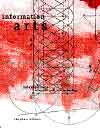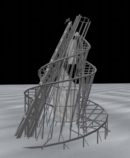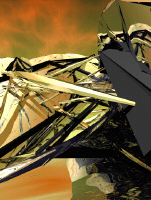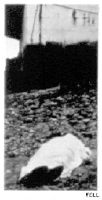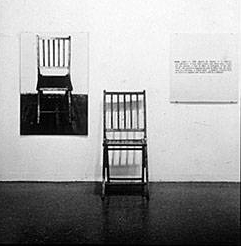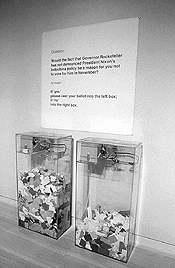MAT200A 02W
Courses : MAT200A 02W : Algorithmic Art : Graham Budgett
schedule MAT200A 02W
Report by: Graham Budgett
Algorithmic Art
- Algorithm & Origins
- Algorithm & Procreation
- Algorithm & Recreation
- Algorithm & Architecture
- Algorithm & Modernity
- Algorithm & Information
- __________*links
The Turing Machine, which many hold to be the precursor of both computer software and hardware, was first proposed by Alan Turing in 1936, in an attempt to give a mathematically precise definition of "algorithm" or "mechanical procedure".
An algorithm is a step-by-step process leading to a solution. It is a logical equivalent to many procedures we use to generate many artifacts. Given instructions with the appropriate materials, we could build a house, a car, even an artwork. The algorithm for production is distinct from its product. Yet generatively related. Artists like Sol Lewitt have long known this. It is an intrinsic part of socially collaborative disciplines like design, engineering and architecture. In fact, we could argue that the relationship between instructions and product is as natural as life itself - that computer algorithms are a pale shadow of material processes underlying the organic world.
Peter Anders, in 'Envisioning Cyberspace'
Peter Anders definition of algorithm touches on my approach to the subject of Algorithmic Art for the purposes of this presentation - to trace the algorithmic beyond 'Computer Art' or 'Digital Art' to a broader, more mature, Information Art and its context.
HOWEVER, LETS GET IT STRAIGHT, WHAT IS OFTEN MEANT BY 'ALGORITHMIC ART'* IS IN FACT ART WHICH SOMEHOW DEPLOYS 'GENETIC ALGORITHMS'
*As others have noted ALL computer-assisted art is algorithmic to some degree since software itself is algorithm.
Genetic algorithms were first developed as robust searching techniques in which populations of test points are evolved by random variation and selection. In areas such as Information Theory and Chaos Research it is anticipated that 'tracking algorithms' will soon provide a key improvement in the control of chaos in technological systems as well as such biological dynamics as pulse rate and brain seizure.
If we take two algorithms - two lists of instructions - and swap discrete elements of code between them we can 'breed' new algorithms which are either 'fit' or 'unfit' for our needs. Karl Sims generates creatures for simulated environments where they fly, swim or sink according to their 'nature'. The computer evalutes and selects them based on dynamism and aesthetics.
He says of the evolutionary model:
When one or more of these images are chosen for survival, they reproduce
by copying and combining their genetic descriptions, often acquiring some
random mutations in the process. The resulting offspring images are generated
from the new genetic descriptions. They may look similar to their parents,
but often have some significant alteration. Since some mutations can add
new terms to the genetic descriptions and increase their complexity, the
resulting images can continue to evolve in unpredictable directions and
increase in visual complexity. In fact, complex equations can sometimes
emerge that would be quite difficult for any human to design or even understand.
Karl Sims, 'Genetic Images'
This is a tried and trusted algorithm within cultural production as well as in 'nature':
take differentiated elements and combine them to produce a unique third element
Historically, notably the Surrealists employed chance strategies and
"the third effect" to generate new possibilities of creativity
and meaning. Surrealism allied itself to the then young sciences
of Psychoanalysis and Marxism, but never lost it's grip on the
absurd as an antidote to orthodoxy.
Now, as art converges with science & technology, artists will need
to maintain at least a semblance of critical distance. Sims' partly 'aesthetic'
approach to selection could produce monsters - like the Surrealist's game
'Divine Corpses'
- depending on whose aesthetics are used in
the name of a cultural
Darwinism.
Artificial Evolution for Computer Graphics - Karl Sims
Christa Sommerer & Laurent Mignonneau
In the interactive real-time environment A-Volve visitors interact
with virtual creatures in the space of a water filled glass pool. These
virtual creatures are products of evolutionary rules and influenced by
human creation and decision. Designing any kind of shape and profile with
their finger on a touch screen, visitors will “bear” virtual
three dimensional creatures, that are automatically “alive”
and swim in the real water of the pool. The movement and behavior of each
virtual creature is decided by its form (which the viewer designed on
the touch screen).
Behavior in space is, so to speak, an expression of form. Form is an expression
of adaptation to the environment. Form and movement are closely connected,
the creatures capability to move will decide its fitness in the pool.
The fittest creature will survive longest and will be able to mate and
reproduce. The creatures will compete by trying to get as much energy
as possible. Thus predator creatures will hunt for prey creatures, trying
to kill them. The creatures also interact with the visitors, by reacting
to their hands movement in the water. If a visitor tries to catch a creature,
it will try to flee or stay still, if it gets caught. Thus the visitor
is able to influence the evolution by for example protecting prey against
predators.
If two strong creatures meet, they can mate and a new creature
can be born. It carries the genetic code of its parents. Mutation and
cross-over provide a nature-like reproduction mechanism, that follows
the genetic rules of Mendel. This newly born offspring will now also react
and live in the pool, interacting with visitors and other creatures. Algorithms,
developed by Mignonneau and Sommerer ensure smooth and natural movement
and “animal-like” behavior of the creatures.
Genetic Art Gregory Dudek - make and mate art!
"Here is an algorithm of the legendary 'Tetris':
when a new block appears, rotate it in such a way so it will complete the top layer of blocks on the bottom of the screen making this layer disappear.
The similarity between the actions expected from the player and computer algorithms is too uncanny to be dismissed. While computer games do not follow database logic, they appear to be ruled by another logic — that of an algorithm. They demand that a player executes an algorithm in order to win."
Natalie Bookchin's game algorithms drive Narrative
In 'Database as Symbolic Form' Lev Manovich posits Database as the logical successor to Narrative as the 'symbolic order' of the Computer Age. He cites web and disk space as manifestations of the database, while computer game 'narratives' are ordered by algorithms. "The projection of these two fundamental parts of computer software — and of the computer's unique ontology — onto the cultural sphere" is Manovich's point. "The computerization of Society" is carried through not just materially, but cognitively - in human perceptions and responses. In his title and argument Manovich favors Database over Algorithm as the age's 'symbolic order' while seemingly downplaying the necessity for algorithmic agency within any database, virtual or actual.
Stephen Wilson's extensive website of links is a case in point. While one appreciates his contribution enormously, without an algorithmic agent constantly surveilling the site for broken links and correcting the problems, it could soon fall into disrepair and obsolescence. Here are all the links from his site referencing 'Algorithmic Art' and 'Algorithms for Creativity' - all working as of January 2002:
Algorists
Roman Verostko
Ken Musgrave
George Legrady
AlgoArts Links
PARC
Algortithmic Art Show
Pioneers
of Algorithmic Art
Music, Mind, Machine Research
Harold Cohen - Aaron main,
links,
links2
Institute for Artificial
Art
Artur Matuck - Landscript
Smart Graphics
conference
MIT Computational Aesthetics
Incidentally, Wilson's book, Information Arts, as well as being extremely useful, replicates this problem IN PRINT.
"jodi.org's pulsing green and black blankness is not so blank as it seems, that is; one just needs to know where to look. In Netscape's tool bar menu, there is a command to view "Document Source." The source code comes up as a text document, and what is revealed is that there is a whole layer of pictorial, ASCII text art "below" the surface of jodi.org."
(...no longer apparent! But here's one from before the change. GB)
Automatic Generation of a Functionally Correct Design Approach Using Genetic Algorithms and Evolution Strategies: ...A stream of spatial units (molecules) that results from the task's specifications (spatial agenda) flows into this predefined, invisible world. When transferring this spatial agenda onto the computer system, these smallest spatial units are allocated a genetic entry corresponding to their respective function. Depending on the use, the spatial units are given different characteristics. A degree of relatedness to another functional area means that the spatial unit in question must be placed in the proximity of the other related units. One side surface of the volume of many of the spatial units, for example, has to be flush with the outside space, i.e. potentially constitute part of the facade. Others have to be part of seamless series of links (e.g. porch, entrance, foyer, reception area). An overall spatial unit (population) generated in this manner can then be tested and assessed in terms of quality (fitness). If a space is not able to take its genetically prescribed spatial place, i.e. next to related spaces, within the population, then the overall result is unsustainable. If the system has, however, found a population that has scored sufficiently well in terms of the internal fitness function, then it appears on the screen as a possible solution in the form of a 3-D mass model. From now on, the user of the system can influence the evolution of the model. The user can individually and formally assess the mass model proposed by the system and then take the solutions that appear most architecturally interesting and transpose their geometrical similarities onto the next generation of solution variants. Various mass models, parts of which have been assessed as good, can now inter-breed. This process of mutation, controlled by the user, can be applied to any number of generations until a basic conception is found, which is then advanced further by conventional means.
Mario Merz Merz's Igloos express his pre-occupation with the fundamentals of human existence: shelter, food and cultural interaction with nature. Many of his works refer to the principles of the Fibonacci series, an exponential mathematical sequence that underlies the growth patterns of natural life. Fibonacci Naples, 1970, consists of ten photographs of factory workers at lunch, gathering from one person to a group numbering fifty-five (55 is equivalent to 10 in the Fibonacci series).
Vladimir Tatlin's 'Monument to the 3rd International' 1920 (left) and a detail of 'paraSurf' by Macus Novak (right).
'Tatlin's Tower', designed to out-Modern and dwarf Eiffels's Paris structure, was never engineered, but exists as various scale models and images. The realised Constructivist tower would have housed Moscow's telephone exchange and Communist Party Headquarters. It features a double helix which adds a dynamism and prescience to it's Modernism.
Marcus Novak's recent 'transarchitecture', existing predominantly in Cyberspace, is algorithmically generated or 'bred' and - like Tatlin's virtual structure - can be interpreted as symbol and agitprop for radical innovation beyond the realm of architecture per se.
In the 'Visual Arts' the period of Modernism spans from the end of the 19th Century (with the ascendancy of Photography & Film) to the present - if you're from one camp - or until the mid-20th Century if you belong to the other. (See arguments about 'Postmodernity')
What happened mid-20th Century was a great tendency in the artworld toward reduction as a response to the perceived moribundity of 'painterly' Abstract-Expressionism and the dominance of Formalist Criticism embodied in the person and works of Clement Greenberg.
Condensation Cube Hans Haacke 1964 - his early works were 'art political' in that they eliminated artistic gesture in favour of system. Later he succesfully hybridized the reductivist aesthetic of his art and his realpolitik (See below: MoMA Poll)
Minimalism & Conceptualism are the best known 'movements' from that period - they shared a systematic, reductive approach to art-making - but there have been others who had that approach:
Harold Cohen has Aaron make paintings which have evolved in complexity since 1973, but still maintain a very 'English' mid-Century Modernity - very R B Kitaj. Having reduced his art-making in a systematic effort to exclude many of the mannered elements of painterly painting, he proceeded to write and refine 'C' code for Aaron which replicates those very elements.
At his recent talk at UCSB I asked him if he felt paternal toward Aaron, "I know the difference between a child and a computer" he responded in characteristically witty and astute fashion.
Cohen claims that he is discovering universals in perception and response to images. Yet AARON has a recognisable style and "signature"
The Algorists - Santa Barbara's own Jean-Pierre Hébert for one. There is an unmistakable Modernist ethic and look to many of their products.
1. THE ARTIST MAY CONSTRUCT THE WORK
2. THE WORK MAY BE FABRICATED
3. THE WORK NEED NOT TO BE BUILT
Resisting the arch formalism that had become institutionalized by the 1960s, Conceptual Art has sought to analyze the ideas underlying the creation and reception of art, rather than to elaborate another stylistic convention in the historical succession of Modernist avant-garde movements. Investigations by Conceptual artists into the networks of signification and structures of knowledge that enable art to have meaning, frequently have utilized text as a strategic device to examine the interstice between visual and verbal languages as semiotic systems. In this regard, Conceptual Art is a meta-critical and self-reflexive art practice, engaged in theorizing the possibilities of signification (including its own) in art's multiple contexts, including its history, criticism, and historiography, its exhibition spaces and markets, and so on. In interrogating the relationship between ideas and art, Conceptual Art de-emphasized the value traditionally accorded to the materiality of art objects and placed greater emphasis on revealing the semantic systems that make it possible for meaning to be communicated.
Edward A. Shanken Art in the Information Age: Technology and Conceptual Art
John Hilliard - Cause of Death
The art critic Jack Burnham wrote in 1970:
Information processing technology influences our notions about creativity,
perception, and the limits of art ... (It) is probably not the province
of computers and other telecommunication devices to produce works of art
as we know it; but they will, in fact be instrumental in redefining the
entire area of esthetic awareness.
Burnham, "Notes on Art and Information Processing" Software
In 1969, Chicago's Museum of Contemporary Art opened a show titled, "Art by Telephone." Thirty artists, including noted conceptualists like Joseph Kosuth, were asked to place telephone calls the Museum and to instruct the staff about what their contribution to the show would be.
The first proposal for a specifically telephonic art was an unrealized
provocation offered by the Dadaists in Berlin in 1920. The Dada-Almanach
proposed that an artist could call in an order for a picture by telephone,
and have it made by an artisan. In 1922, Lázló Maholy-Nagy
claims to have indeed ordered five paintings in porcelain enamel by telephone
from a sign factory. According to Maholy-Nagy, these Telephonbilder as
he called them, were created when he sketched out his paintings on graph
paper with the color chart from the factory in front of him, and relayed
his instruction via the telephone to the supervisor of the factory at
the other end of the line. Moholy-Nagy wrote years later of the process:
the supervisor "took down the dictated shapes in the correct position.
(It was like playing chess by correspondence.)"
Peter Lunenfeld In Search of the Telephone Opera
Joseph Kosuth exhibited elements of his "Seventh Investigation (Art
as Idea as Idea) Proposition One" (1970) in the Jack Burnham curated
Software exhibition. This work included the same text in various international
contexts: a billboard in English and Chinese in the Chinatown neighborhood
of lower Manhattan, an advertisement in The Daily World, and a banner
in Turin (in Italian, which was temporarily on display at the Museum of
Modern Art's Information exhibition.) The text was comprised of a set
of six propositions:
[1] to assume a mental set voluntarily.
[2] to shift voluntarily from one aspect of the situation to another.
[3] to keep in mind simultaneously various aspects.
[4] to grasp the essential of a given whole; to break up a given whole
into parts and to isolate them voluntarily.
[5] to generalize; to abstract common properties; to plan ahead ideationally;
to assume an attitude toward the 'mere possible' and to think or perform
symbolically.
[6] to detach our ego from the outer world.45Kosuth's statement in the
Software catalog emphasized his intention that the work not be able to
be reduced to a mental image, but that it exist as information free of
any iconography.
Kolmogorov Complexity in Information Theory "Roughly, the Kolmogorov complexity of a sequence of symbols is the shortest computer program which will generate that sequence as its output. For certain classes of random processes, the Kolmogorov complexity per symbol converges, on average, to the entropy per symbol, which in that case is the entropy rate, the entropy of the latest symbol, conditioned on all the previous ones. This gives us a pretty profound result: random sequences are incompressible; and, conversely, an incompressible sequence looks random. In fact it turns out that one can write down formal analogs to almost all the usual theorems about information which talk, not about the entropy, but about the length of the Kolmogorov program, also for this reason called the algorithmic information."
Five Words in Green Neon Joseph Kosuth
Hans Haacke - MoMA Poll, 1970
The life of language. Grammars of languages constitute a creation formalism that can be compared with the algorithm of plant growth In such grammars, information is furthermore encoded in such a way that they can serve as general models.
Peter Weibel ABOUT GENETIC ART
Graham Budgett 2002



